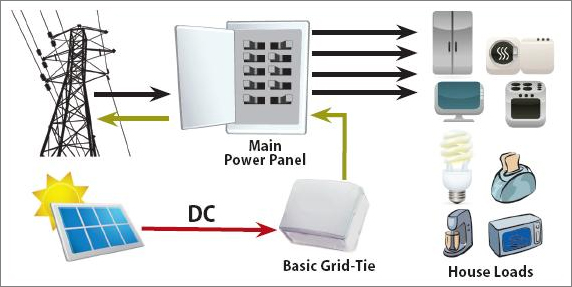

OFF GRID (With Battery)
Solar Energy concept a key to achieving high penetration of photovoltaic (PV) systems into the utility grid. A stand-alone or off-grid system uses battery power storage to provide back-up during hours of darkness, power outages or during high demand.

The Power from a renewable energy source (a solar array) runs to a Maximum Power Point Tracking (MPPT) charge controller that regulates the charging of the batteries of your battery bank (typically LMLA/VRLA type). Battery bank voltages are typically 12V, 24V, 48V. Power from the battery runs thru a Pure Sine Wave Inverter/Charger where the DC power is converted to AC power. AC power goes to both the main panel (where excess power can be sold back to the utility) and to a sub-panel or secure load panel which has loads to be backed-up during a utility outage. Advanced, integrated inverter/controllers will be the enabling technology to maximize the benefits of residential and commercial solar energy systems, both to the system owners and to the utility distribution network as a whole.
ON GRID (Without Battery)
An on-grid/grid tie system, uses no battery for power storage, these kinds of systems are for the load requirements during day time.

The power produced from the solar array runs to the Grid-Tie inverter which converts the DC power into AC power, which flows to the utility grid connected in parallel with the load; the main electrical appliances. There will be no batteries in this type of system, and solar power usage is restricted to the availability of sunlight. The inverters used contain built-in intelligence which will enable the capability to characterize the integration interface and to adapt to the anticipated and real changes related to the state of the utility grid.
Advanced, integrated inverter/controllers will be the enabling technology to maximize the benefits of residential and commercial solar energy systems, both to the system owners and to the utility distribution network as a whole.
Authorized Dealer:
